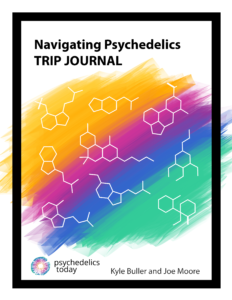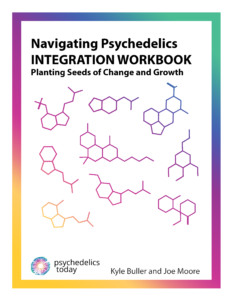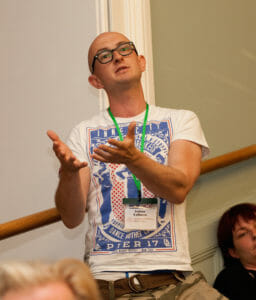Download
In this episode, Joe interviews Computational Neuro-Biologist, Dr. Andrew Gallimore, one of the world's knowledgeable researchers on DMT. In the show they discuss DMT and the possibilities of being in an extended state of DMT, such as accessing higher dimensions and communicating with intelligent entities.
3 Key Points:
- This reality that we are in is a lower dimensional slice of a higher dimensional structure. DMT is a technology or tool that allows us access to reach out to these higher dimensions.
- Andrew has developed and written about the Intravenous Infusion Model, which allows a timed and steady release of DMT to induce an extended state DMT experience.
- Extended state DMT hypothesizes that with enough time spent in the DMT space, the 'map' of the space would begin stabilize over time and you could develop a 'life' in the DMT space like we do in our waking life.

Support the show

Trip Journal Integration Workbook


Show Notes
About Andrew
- Since age 15, he was into psychedelic drugs and altered states of consciousness
- He was at a friends house and was looking at a book called Alternative London and it had writings on different psychedelics but only a very short segment on DMT
- His fascination grew from his yearning to learn more about DMT
- His interest turned into academic work, learning chemistry and pharmacology and he is now into learning more about the brain itself
- He is currently a Computational Neuro-Biologist
DMT
- DMT is a compound found almost everywhere in nature, highly illegal, yet highly interesting
- Interaction with entities are common
- All frames of reference are gone
- Andrew says that the first few times were very intense and he would come back with no way to comprehend or describe it
- Then after a few more times he started to see the entities and have a more stable experience with more intent
- Andrew describes a very vivid experience of a man in a dark robe where he asked him "show me what you've got" and he opened his mouth and Andrew woke up a if he had seen God himself. He describes it as a shattering experience
- These beings in the DMT experience, aren't just pointless beings in a dream, they are powerful and extremely intelligent
- We don't have any way to comprehend the levels of intelligence in this dimensional space, we only are ever able to experience intelligence with our human capacity for what intelligence is
- There is a sense that these beings are intelligent because they have been around for billions and billions of years or potentially infinitely
Communicating with Intelligent Entities
- He calls his book the 'textbook of the future'
- "We are imprisoned in some kind of work of art" - Terence McKenna
- This reality is a construct or artifact of the alien intelligence or the 'other'
- "This reality that we are in is a lower dimensional slice of a higher dimensional structure. DMT is a technology or tool that allows us access to reach out to these higher dimensions" - Andrew
- DMT is everywhere
- "Nature is drenched in DMT, but it takes a high level of sophisticated intelligence to identify it, isolate it, and discover a means of using it as a tool" - Dennis McKenna
- "In order to communicate with these beings, we need to bring the right tools to the table" - Andrew
- Target Controlled Intravenous Infusion Model - using the same model for DMT as the anesthesia model
- It uses administration of a short acting drug using a mathematical model to control the release
- "We are not just passive receivers of information but we are actively constructing our world from moment to moment." - Andrew
- Continuity Hypothesis of Dreaming - it says that dreaming is continuous with our waking life, the brain constructs the world when you're asleep in the same way that it does when you're awake
Extended State DMT (DMTx)
- Our brains are constantly updating its model of reality, so if you put someone through the DMT space for months at a time, that person's model of reality would completely shift
- This idea has been completely unexplored
- The hypothesis is that an extended time in the DMT space would begin to make that space more stable over time, the goal being to live in the DMT space as you would in this reality of waking life
- The measurement of DMT in the blood with Ayahuasca is 1/5th the level of DMT in the blood as a breakthrough DMT experience
- Andrew hasn't heard of anyone trying the Intravenous Infusion Model yet
- There is this space that exists one quantum away, and it is accessible by everyone (technologically, not necessarily legally)
- Inter-dimensional citizenship is close at hand
Links
Book
Alien Information Theory: Psychedelic Drug Technologies and the Cosmic Game
Website
Instagram
Twitter
About Dr. Andrew Gallimore
 Dr. Andrew Gallimore is a computational neurobiologist, pharmacologist, chemist, and writer who has been interested in the neural basis of psychedelic drug action for many years and is the author of a number of articles and research papers on the powerful psychedelic drug, N,N-dimethyltryptamine (DMT), as well as the book Alien Information Theory: Psychedelic Drug Technologies and the Cosmic Game (April 2019). He recently collaborated with DMT pioneer Dr. Rick Strassman, author of DMT: The Spirit Molecule, to develop a pharmacokinetic model of DMT as the basis of a target-controlled intravenous infusion protocol for extended journeys in DMT space. His current interests focus on DMT as a tool for gating access to extradimensional realities and how this can be understood in terms of the neuroscience of information. He currently lives and works in Japan.
Dr. Andrew Gallimore is a computational neurobiologist, pharmacologist, chemist, and writer who has been interested in the neural basis of psychedelic drug action for many years and is the author of a number of articles and research papers on the powerful psychedelic drug, N,N-dimethyltryptamine (DMT), as well as the book Alien Information Theory: Psychedelic Drug Technologies and the Cosmic Game (April 2019). He recently collaborated with DMT pioneer Dr. Rick Strassman, author of DMT: The Spirit Molecule, to develop a pharmacokinetic model of DMT as the basis of a target-controlled intravenous infusion protocol for extended journeys in DMT space. His current interests focus on DMT as a tool for gating access to extradimensional realities and how this can be understood in terms of the neuroscience of information. He currently lives and works in Japan.


 Dr. Andrew Gallimore is a computational neurobiologist, pharmacologist, chemist, and writer who has been interested in the neural basis of psychedelic drug action for many years and is the author of a number of articles and research papers on the powerful psychedelic drug, N,N-dimethyltryptamine (DMT), as well as the book Alien Information Theory: Psychedelic Drug Technologies and the Cosmic Game (April 2019). He recently collaborated with DMT pioneer Dr. Rick Strassman, author of DMT: The Spirit Molecule, to develop a pharmacokinetic model of DMT as the basis of a target-controlled intravenous infusion protocol for extended journeys in DMT space. His current interests focus on DMT as a tool for gating access to extradimensional realities and how this can be understood in terms of the neuroscience of information. He currently lives and works in Japan.
Dr. Andrew Gallimore is a computational neurobiologist, pharmacologist, chemist, and writer who has been interested in the neural basis of psychedelic drug action for many years and is the author of a number of articles and research papers on the powerful psychedelic drug, N,N-dimethyltryptamine (DMT), as well as the book Alien Information Theory: Psychedelic Drug Technologies and the Cosmic Game (April 2019). He recently collaborated with DMT pioneer Dr. Rick Strassman, author of DMT: The Spirit Molecule, to develop a pharmacokinetic model of DMT as the basis of a target-controlled intravenous infusion protocol for extended journeys in DMT space. His current interests focus on DMT as a tool for gating access to extradimensional realities and how this can be understood in terms of the neuroscience of information. He currently lives and works in Japan.